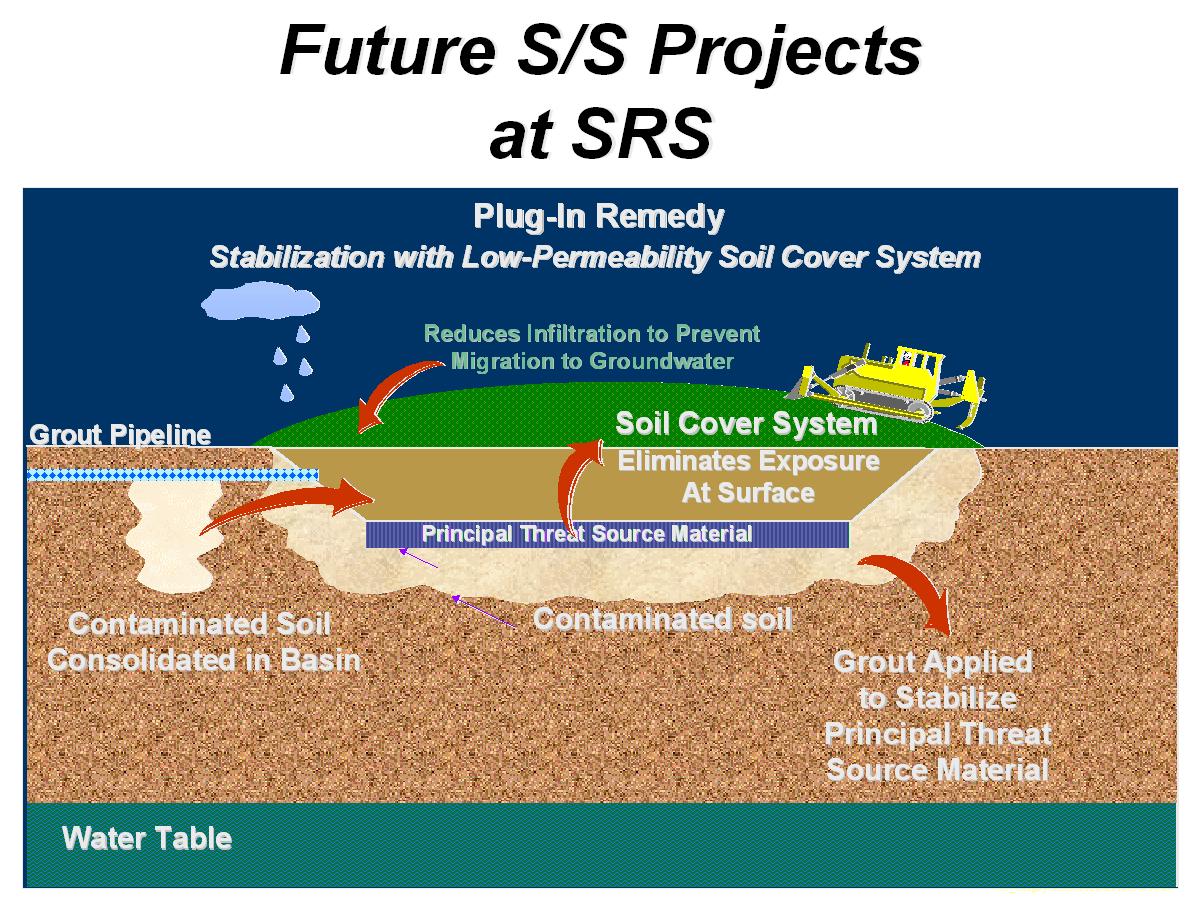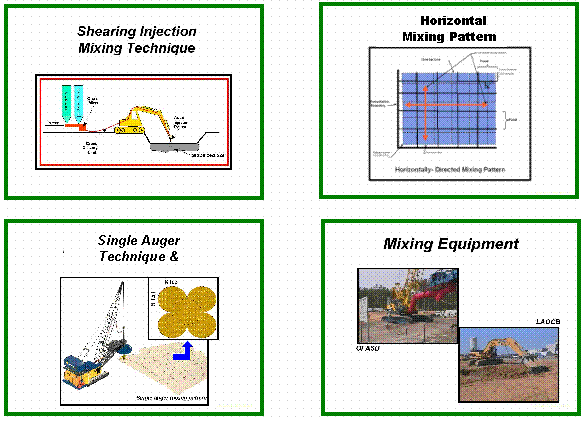
WSRC-MS-2001-00092
Optimization of Remedial Design for Remediation
of SRSís Radioactive
Seepage Basins by In Situ Stabilization/Solidification
Amit Ganguly
Westinghouse Savannah River Company
Aiken, SC 29808
This report was prepared as an account of work sponsored by an agency of the United States Government. Neither the United States Government nor any agency thereof, nor any of their employees, makes any warranty, express or implied, or assumes any legal liability or responsibility for the accuracy, completeness, or usefulness of any information, apparatus, product or process disclosed, or represents that its use would not infringe privately owned rights. Reference herein to any specific commercial product, process or service by trade name, trademark, manufacturer, or otherwise does not necessarily constitute or imply its endorsement, recommendation, or favoring by the United States Government or any agency thereof. The views and opinions of authors expressed herein do not necessarily state or reflect those of the United States Government or any agency thereof.
This report has been reproduced directly from the best available copy.
Available for sale to the public, in paper, from: U.S. Department of Commerce, National Technical Information Service, 5285 Port Royal Road, Springfield, VA 22161, phone: (800) 553-6847, fax: (703) 605-6900, email: orders@ntis.fedworld.gov online ordering: http://www.ntis.gov/support/ordering.htm
Available electronically at http://www.osti.gov/bridge/
Available for a processing fee to U.S. Department of Energy and its contractors, in paper, from: U.S. Department of Energy, Office of Scientific and Technical Information, P.O. Box 62, Oak Ridge, TN 37831-0062, phone: (865 ) 576-8401, fax: (865) 576-5728, email: reports@adonis.osti.gov
Historical Background
The Savannah River Site (SRS) located adjacent to the Savannah River, in Aiken and Barnwell counties of western South Carolina. SRS is owned by the United States Department of Energy (US DOE). SRS has historically produced special nuclear materials for our nationís defense programs. This effort was discontinued in 1988. Chemical and radioactive wastes are by-products of nuclear material production processes. These wastes have been treated, stored, and in some cases, disposed of at SRS.
The Savannah River Site recently began remediation of several radiologically contaminated basins. These unlined basins contain radiological contaminants, which potentially pose significant risks to human health and the environment.
Waste materials handled at SRS are regulated and managed under Resource Conservation Recovery Act (RCRA)/Comprehensive Environmental Response, Compensation and Liability Act (CERCLA). Selection of the remedy, required to protect human health and the environment, is based on the National Oil and Hazardous Substance Contingency Plan (NCP) selection criteria. The final selected remedy is typically summarized in the Record of Decision (ROD) for the waste unit. The completion of the ROD process requires agreement between US DOE, US EPA, SCDHEC, and the public.
A plug-in approach was used and recorded in a "Plug-In-ROD" to design a common remedy for such radioactively contaminated basins with similarities in history of use, contaminants, risk, and location in current industrial use areas adjacent to existing nuclear facilities. This plug-in approach allows early remediation with considerable cost savings through reduction in documentation.
The selected remedy consists of the following actions:
The remedial action objectives were to-

Conceptual Model of Remedy
Stabilization/Solidification (S/S) Technique & Process
In situ stabilization is a well-known technique for immobilizing contaminants within soil and preventing the spread of contamination into the groundwater. The soil is mixed with cement or other grout that chemically absorbs and immobilizes the contaminant materials.
In situ stabilization/solidification of three basins (considered as lead basins) were completed in between late spring of 2000 and early spring of 2001. Lessons learned from these projects are being used to optimize the remedial design and construction requirements for stabilization/solidification of the plug-in candidate basins.
For the lead basins following activities were performed as an integrated set of tasks that would result in the successful completion of the S/S of wastes in the basin soils and pipelines:
Verification of successful completion of S/S was performed through quality control inspection and testing of S/S waste samples. Considering that in-situ soil stabilization/solidification, for treating radiological constituents of concerns is an evolving technology, a conservative approach was taken in the determination of performance criteria for the stabilized/solidified waste in those basins. The performance requirements for verification of successful S/S of wastes were derived from the results of a treatability study and US EPA guidance documents. 28-day compressive strength and leachability were the primary criteria. Additional secondary criteria (for S/S process control) were hydraulic conductivity, pH, temperature, gas generation, radiation exposure, effects of nitrite/nitrate, sulphite/sulphate, strength of the S/S waste under immersed and irradiated conditions, etc.
Several successful Portland cement based grout mixes were developed through the process of bench-scale development and testing of basin waste samples mixed with treatment reagents in the laboratory. Typically grout mixes were composed of Type I or Type II Portland cement mixed with various proportions of silicate (in blast furnace slag or zeolite form), bentonite, fly ash and super plasticizer (in a few applications to enhance mixing operation). Consistent with SRS geology, soil types ranged from silty-sand to clayey sand to sandy clay. Occasionally stiff clay was encountered at basin bottoms, which required application of super plasticizer.
Shallow soil mixing techniques were selected for the stabilization/solidification treatment. The first two projects started with two different type of S/S technique and equipment Ė one with the horizontal mixing technique with a shearing injector equipment and the other with vertical column mixing technique with single auger equipment.

The single auger mixing technique encountered less number of constructibility issues when compared with the single auger mixing technique. Both techniques required multiple pilot tests to determine the necessary operational parameters (e.g., grout flow rate, mixing time, number of passes, etc.) for mixing the clayey soils at basin bottom. However, because of its equipment configuration (limited depth of mixing and slow energy during horizontal mixing and cross mixing) the shearing injector technique required mixing in at least two layers. It also encountered relatively more problems related to ensuring uniform mixing at interfaces (either at the joint of two layers or at the required target depth). In addition, number of test samples required for verification testing of primary criteria (acceptance criteria) and secondary test parameters (for process control) were significantly large. Consequently, the process of sample collection, analysis and testing became very involved and expensive.
Lessons Learned
The lessons learned from the S/S of aforementioned lead basins may be summarized as follows:
Optimization of S/S design
Optimization of S/S design entailed the following steps:
Results of the optimization of S/S design are as follows:
Grout mix optimization (pre-designed grout mix):
Optimization of Field implementation of S/S
Optimized Acceptance Criteria for S/S
The Acceptance criteria for the stabilized/solidified waste are as follows: